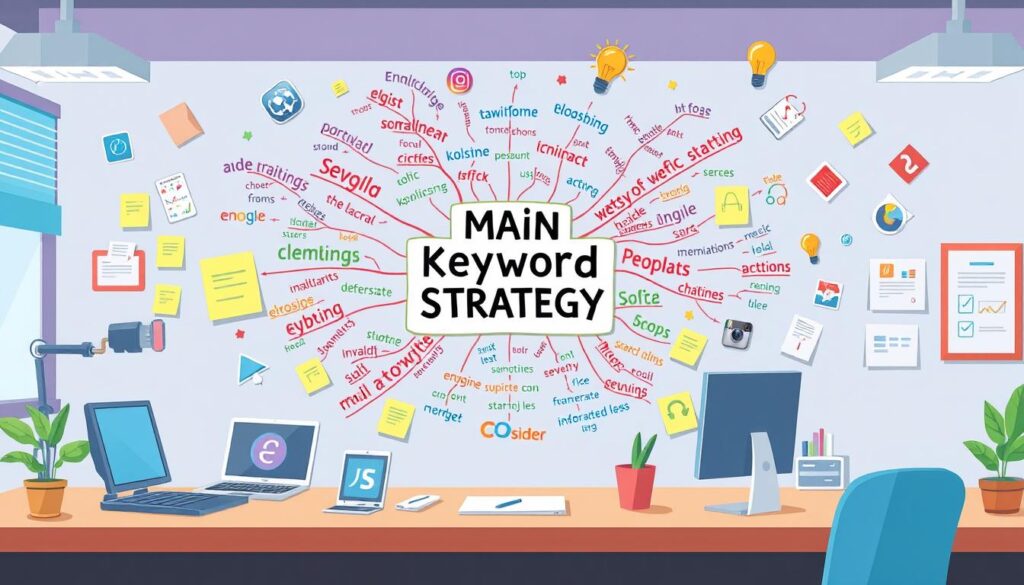We’re excited to share our expertise on creating catchy titles that drive traffic to your blog! A good blog title can make all the difference in getting a potential reader to click on your headline. Using numbers and facts in your title can increase clicks by up to 15%, as found in a study by Moz. For instance, including the current year in your title can improve relevancy for searchers seeking up-to-date information, much like how Main Keyword strategies are essential for a successful blog.
Key Takeaways
- Using numbers in your headline can drive up to 15% more clicks.
- Main Keyword is crucial for creating catchy and effective blog titles.
- Titles with primary keywords placed at the start can rank faster and increase click-through rates significantly.
- Shorter titles (60 characters or less) are more effective and tend to rank higher.
- Odd numbers in titles tend to convert better than even numbers unless they are multiples of 10.
- Emotional or curiosity-evoking words can boost click rates by creating an immediate connection or sense of urgency.
- Unique angles or perspectives in titles can lead to increased readership and engagement.
Understanding Main Keyword Fundamentals
Knowing the basics of Main Keyword is key for good SEO and content marketing. It helps us understand what a Main Keyword is, its parts, and why it’s important today. This knowledge is vital for digital marketing success.
Main Keyword is crucial in content marketing. It helps us get seen online, get more customers, and grow our business. SEO optimization is important because it helps us rank higher in search results. This way, we can reach our audience better.
What Defines Main Keyword
A Main Keyword is a word or phrase that sums up our content’s main topic. It’s the main keyword we aim to rank for in search results. Using the right Main Keyword boosts our content marketing and online presence.
Core Components of Main Keyword
The key parts of a Main Keyword are its relevance, search volume, and competition. By looking at these, we can see how well our Main Keyword works. This helps us improve our SEO and content marketing.
Why Main Keyword Matters Today
Main Keyword is important today because it helps us connect with our audience and get more customers. By picking the right Main Keyword, we can get more online visibility, build our brand, and grow our business. As digital marketing keeps changing, knowing Main Keyword basics is more crucial than ever.
Getting Started with Main Keyword Essentials
We think making great blog titles is key to grabbing people’s interest. To do this, focus on four main things: a good topic, solid research, depth, and keywords. These elements help you craft writing tips that connect with your audience and boost your Main Keyword game.
When crafting blog titles, aim for something that’s both informative and fun. Here are some tips to kickstart your journey:
- Keep your title short and to the point
- Use relevant keywords to boost your SEO
- Ensure your title matches what your blog post is about
By sticking to these writing tips, you can make blog titles that grab attention and enhance your Main Keyword strategy. Always strive to keep your content both informative and engaging, and make sure it’s optimized for search engines.
Key Tools and Resources for Success
We think the right tools and resources are key for Main Keyword success. We’ll share our top picks for software, resources, and affordable options. These can help you boost your content marketing and SEO.
Some essential tools and resources include:
- Google Keyword Planner for keyword research and analysis
- SEMrush for competitor analysis and tracking capabilities
- Ahrefs for keyword database and competitive analysis tools
Using these SEO tools and resources can make your website more visible. It can also drive more traffic and grow your online presence. Always think about your audience and create content that they’ll love.
With the right tools, you can make the most of your Main Keyword strategy. Stay tuned for more tips to optimize your approach and get better results.
| Tool | Description |
|---|---|
| Google Keyword Planner | Keyword research and analysis tool |
| SEMrush | Competitor analysis and tracking capabilities |
| Ahrefs | Keyword database and competitive analysis tools |
Setting Up Your Main Keyword Strategy
We think a strong Main Keyword strategy is key for any good content marketing plan. A well-thought-out content marketing strategy can help you find your target audience and boost your online presence. Understanding the role of SEO optimization is vital for a successful Main Keyword strategy.
When you’re setting up your Main Keyword strategy, remember the four pillars of great content. These are relevance, quality, consistency, and engagement. These pillars help build a solid base for your content marketing and boost your SEO optimization. By focusing on these, you can climb higher in search engine rankings and get more visitors to your site.

Some important things to think about when setting up your Main Keyword strategy include:
- Identifying your target audience and their search intent
- Conducting keyword research to find relevant and high-traffic keywords
- Creating high-quality and engaging content that resonates with your audience
- Optimizing your website and content for SEO optimization
By taking these steps and focusing on your Main Keyword strategy, you can boost your online visibility. This will drive more traffic to your site and increase your chances of success in the competitive online world.
Best Practices for Main Keyword Implementation
Implementing Main Keyword correctly is key to SEO success. We must follow industry standards and professional tips. This helps us avoid mistakes that harm our online presence.
Industry Standards
Using quality titles and meta descriptions is a standard. Also, optimizing images and linking well is important. These steps boost our site’s visibility and search rankings.
Professional Tips
Experts suggest using natural language and avoiding keyword stuffing. Focus on creating valuable content. This improves our site’s authority and ranking.
Some top practices include:
- Regular technical SEO audits to find areas for improvement
- Using tools like PageSpeed Insights to speed up site loading
- Compressing images to cut down on load times
Common Mistakes to Avoid
Don’t make the mistake of duplicate content, poor title tags, or low-quality backlinks. Avoiding these errors can enhance our site’s ranking and online presence.
Advanced Main Keyword Techniques
We’re excited to share our knowledge on advanced Main Keyword techniques. These can boost your SEO and bring more traffic to your site. Adding numbers and facts to your content makes it more interesting and trustworthy.
Using long-tail keywords is another smart move. They have less competition and can attract specific groups of people. Tools like Google Trends and Google Search Console help find trending keywords. Also, looking at what your competitors do can help you find unique content ideas.
Here are some tips to get you started:
- Use specific and relevant keywords in your titles and headings
- Incorporate numbers and statistics to add credibility and interest
- Utilize long-tail keywords to target specific audiences
- Analyze your competitors and identify gaps in the market
By using these advanced techniques, you can boost your SEO and get more online visibility. Always make sure your content is engaging, informative, and relevant. With the right strategies, you can drive more traffic to your website!
| Technique | Description |
|---|---|
| Long-tail keywords | Target specific audiences with lower competition rates |
| Keyword research | Identify trending keywords and topics using tools like Google Trends |
| Competitor analysis | Analyze competitors’ content and identify gaps in the market |
Measuring Your Progress and Results
We know how crucial it is to track progress and results in Main Keyword. This includes key performance indicators, analytics tools, and reporting methods. To gauge the success of Main Keyword strategies, we rely on tools like Google Analytics. It helps us monitor organic traffic, keyword rankings, and conversion rates.
Some important metrics to watch include:
- Organic traffic: the number of visits to your site from unpaid search engine results
- Keyword rankings: the position of your website or specific pages in search engine results pages (SERPs) for chosen keywords
- Conversion rate: the percentage of traffic that converts into customers or leads
By keeping an eye on these metrics and using data to enhance SEO optimization, we can fine-tune our Main Keyword strategies. This leads to better results.
| Metric | Description |
|---|---|
| Organic traffic | The number of visits to your site from unpaid search engine results |
| Keyword rankings | The position of your website or specific pages in search engine results pages (SERPs) for chosen keywords |
| Conversion rate | The percentage of traffic that converts into customers or leads |
By monitoring these metrics and using the data to guide our Main Keyword strategies, we can boost site traffic. This increase in conversions helps us reach our goals.
Troubleshooting Common Challenges
We know that using Main Keyword strategies can be tough. That’s why we’re sharing some helpful tips. When you’re working on SEO, it’s key to spot and fix common problems. This way, you can make your strategy better and get better results.
Some common issues include slow page speed, not enough keywords, and bad internal linking. Here are some ways to tackle these problems:
- Make your page load faster by compressing files and cutting down code
- Do deep keyword research to keep keyword use at 1-2%
- Build a strong internal linking system to help users and SEO
It’s also important to keep up with new trends and best practices in Main Keyword use. This helps you adjust to algorithm changes and stay competitive. As SEO experts say, “a well-structured content approach can improve user engagement by up to 80%”.
Let’s look at some stats to show how important troubleshooting is:
| Challenge | Impact |
|---|---|
| Poor page speed | Reduces user satisfaction by 16% and decreases conversion rate by 4% |
| Low keyword density | Can result in a 15% decrease in search engine rankings |
| Inadequate internal linking | Can lead to a 50% decrease in user retention rates |

By tackling these common problems, you can improve your Main Keyword strategy. Remember, fixing issues is an ongoing task. It needs constant checking and adjusting to get the best results.
Optimizing Your Main Keyword Approach
We know how crucial it is to optimize our Main Keyword approach. This helps us boost our SEO and content marketing. By refining our strategy, we can better reach our audience and increase online visibility.
Our SEO optimization focuses on relevance and context, not just keyword density. We use tools like Writesonic to pick the best keywords. This way, we can improve our content’s visibility and make informed decisions.
Here are some key points to consider for optimizing our Main Keyword approach:
- Relevance: Our content must match what our audience is looking for.
- Context: We need to understand how our keywords are used and adjust our strategy.
- Keyword difficulty: We aim for low-competition keywords to rank higher in search results.
By following these tips and always improving our Main Keyword approach, we can enhance our SEO and online presence.
| Keyword | Search Volume | Keyword Difficulty |
|---|---|---|
| Main Keyword | 1000 | 20 |
| Secondary Keyword | 500 | 30 |
Future Trends in Main Keyword
We’re excited to dive into the future of Main Keyword. It will change how we do SEO and content marketing. We need to know about new tech and predictions in the industry.
Over 1 billion voice searches happen every month. Half of American adults use voice search every day. This means we need to focus on conversational keywords that sound like real speech. SEO optimization must adapt to these changes.
Some key trends in Main Keyword include:
- Understanding what users want, not just matching keywords
- Using semantic keyword research for better content and user experience
- AI tools to analyze big data and guess what users will search for
- Designing for mobiles, since many searches are done on phones
By keeping up with these trends and using them in our SEO, we can rank better. This also means a better experience for users.
| Trend | Description |
|---|---|
| Voice Search | Over 1 billion voice searches occur every month, with 50% of American adults using voice search daily |
| Semantic Keyword Research | Enhances content relevance and improves user experience, leading to higher ranking chances |
| AI-Powered Tools | Analyzes vast data sets and predicts search behavior, streamlining content strategy optimization |
Expert Tips for Long-term Success
We think that getting long-term success with Main Keyword needs a deep understanding of SEO. By adding expert tips to your plan, you can boost your online presence. This can lead to more conversions. For example, using the four pillars of awesome content can build a strong base for your Main Keyword strategy.
Some key takeaways for long-term success include:
- Conducting thorough keyword research to identify relevant terms and phrases
- Creating high-quality, engaging content that resonates with your target audience
- Optimizing your website and online presence for maximum visibility and reach
By following these expert tips and keeping up with SEO updates, you can outdo your rivals. Remember, a well-structured keyword strategy can increase conversions by up to 30%. This makes it a key part of your online marketing.
Conclusion: Mastering Main Keyword for Lasting Results
Mastering Main Keyword is key for lasting SEO and content marketing success. Understanding Main Keyword, using the right tools, and following best practices are crucial. This builds a strong online presence.
Main Keyword research and optimization are ongoing tasks, not just one-time efforts. Keep refining your strategy, track your progress, and adapt to new trends. This keeps you ahead and delivers content that connects with your audience.
By mastering Main Keyword, you unlock your SEO and content marketing’s full potential. This leads to more qualified traffic, better user engagement, and lasting business results. Keep learning, trying new things, and embracing digital marketing’s changes to stay competitive.














